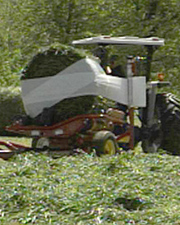Baled Silage Offers Farmers High Quality Feed
Baled Silage Offers Farmers High Quality Feed

Most Kentucky farmers don't have the equipment needed to take advantage of using traditional chopped silage to feed their livestock, but baled silage offers farmers that option.
Baled silage allows farmers the opportunity to gain the forage quality and yield retention that silage provides at a lower initial cost than chopped silage.
Kentucky has problems with its forage harvesting with rains often causing damage to many hay crops. Also, about a third of the crop is lost due to storage under typical conditions. "With large losses in yield and quality, I think we definitely need to take a look at some ways of improving the quality of our forages, especially with legumes," said Michael Collins, University of Kentucky agronomist. "They are the best forage but the most difficult to put up as hay."
Silage offers an opportunity to avoid rain damage during harvest because the crop only needs to be left in the field overnight in most cases to be ready to bale. Another advantage in preserving legumes such as alfalfa and red clover is that more of the leaf is retained when the crop is put up at a higher moisture level.
Good silage preservation depends on the development and maintenance of anaerobic conditions. Generally, grass silage is easier to preserve than legume silage because grasses have higher sugar concentrations, have a lower pH and are more stable, Collins said. Because of these differences, legume stands with grass would be most suitable for silage production. Because of the differences between the two, Collins suggests that farmers begin with grass when starting to make baled silage.
All the major forage crops grown in Kentucky can be harvested effectively as balage. Round bale silage has several advantages, Collins said, but it also has some concerns or disadvantages to consider.
Disadvantages include handling heavy bales, maintaining plastic integrity, adapting baling equipment to handle wet forage and plastic disposal.
Silage bales generally weigh about twice as much as similar sized bales of dry hay. Recommended moisture levels for baled silage are generally between 45 and 65 percent, said Collins.
With variable chamber balers, bale diameter can be reduced if necessary to reduce bale weight. Bales should be formed as tightly as practical. Slower ground speeds during baling increase density.
Bales can be handled with bale spikes prior to being wrapped in the plastic that allows the ensilage process to take place. Once the bales are encased in plastic, making any holes in the plastic should be avoided.
Generally, two types of bale wrappers are used in the state. One is an individual bale wrapper which uses a single roll of UV-treated stretch film. The cost varies widely from $5,000 to $12,000 or more. Four layers are recommended unless the bales are dry or are intended for long-term storage in which case six layers should be used.
In-line wrappers push bales through a hoop on which two or three rolls of plastic film move around the bale as it is pushed through. Only at the beginning and end of the line of bales is plastic used to cover the ends. Six layers of film are recommended for in-line wrappers. These wrappers generally cost more than the upper-end models of the individual wrappers.
Plastic cost per bale is around $2.50 for four layers of film and an individual wrap machine, Collins said. In-line wrappers use less film.
Some counties have purchased the wrapping machines making them available to producers and as the practice becomes more common, custom operators are also becoming available in some areas.
For more information on baled silage, contact your local University of Kentucky Cooperative Extension Service office.
